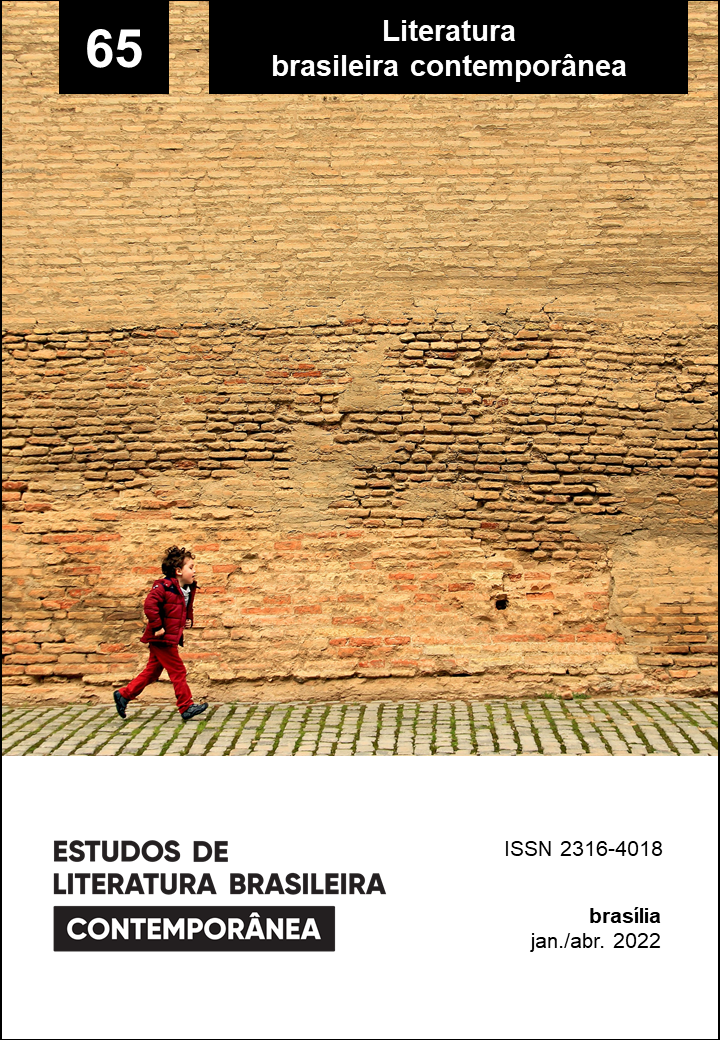A Cataguases de Luiz Ruffato: a experiência urbana no interior mineiro
Keywords:
Cataguases, urban, Luiz RuffatoAbstract
In this article, we reflect on what we understand by urban in Luiz Ruffato’s literature. Ever since the representation of São Paulo in Eles eram muitos cavalos, the author has been considered a relevant name by literary critics to think about cities in contemporary works. However, after the release of the novel, Ruffato began to focus on the countryside of Minas Gerais, specifically the city of Cataguases, in his writing. As such, the author's literature expands a common notion of urbanity that limits itself to considering modernization only in relation to large metropolitan areas. In our reading, we defend that certain characteristics of urban literature, such as social inequality, the marginalization of poor individuals’ spaces, the rigid borders that separate the different social classes, are present in the ruffatian narratives about Cataguases. Thus, we conclude that, when dealing with the literature of Luiz Ruffato, São Paulo and Cataguases compose two points of the same thematic thread that explores the hardships of implementing an ill-fated modernization project in Brazil.
Downloads
References
BARRETO, Lima (1997). Triste fim de Policarpo Quaresma. São Paulo: Editora Globo.
CANDIDO, Antonio (1989). A nova narrativa. In: CANDIDO, Antonio. Educação pela noite e outros ensaios. São Paulo: Ática. p. 199-215.
CARNEIRO, Flávio (2005). Ficção brasileira do século XXI. Rio de Janeiro: Rocco.
DALCASTAGNÈ, Regina; AZEVEDO, Luciene (2015). Apresentação. In: DALCASTAGNÈ, Regina; AZEVEDO, Luciene (org.). Espaços possíveis na literatura brasileira contemporânea. Porto Alegre: Zouk. p. 11-17.
DELGADO, Gabriel Estides (2014). A negociação social do espaço em Inferno Provisório, de Luiz Ruffato. Dissertação (Mestrado em Literatura) –Universidade de Brasília, Brasília. Disponível em: https://bit.ly/3Qi6F6U. Acesso em: 1º dez. 2019.
FIGUEIREDO, Vera Follain de (1996). A cidade e a geografia do crime na ficção de Rubem Fonseca. Literatura e Sociedade, v. 1, n. 1, p. 88-93. Disponível em: http://www.revistas.usp.br/ls/article/view/684/692. Acesso em: 2 dez. 2019.
GABRIEL, Ruan de Sousa (2022). De volta ao Brasil profundo: editoras apostam em obras de novos autores ambientadas no interior do país. O Globo, Rio de Janeiro, 26 mar. Disponível em: https://oglobo.globo.com/cultura/livros/de-volta-ao-brasil-profundo-editoras-apostam-em-obras-de-novos-autores-ambientadas-no-interior-do-pais-1-25449040. Acesso em: 12 maio 2022.
GOMES, Renato Cordeiro (2008). Todas as cidades, a cidade: a literatura e experiência urbana. Rio de Janeiro: Rocco.
HOSSNE, Andrea Saad (2007). Degradação e acumulação: considerações sobre algumas obras de Luiz Ruffato. In: HARRISON, Marguerite Itamar. Uma cidade em camadas: ensaios sobre o romance Eles eram muitos cavalos, de Luiz Ruffato. São Paulo: Editora Horizonte. p. 18-42.
LEHNEN, Leila (2007). Os não-espaços da metrópole: espaço urbano e violência social em Eles eram muitos cavalos, de Luiz Ruffato. In: HARRISON, Marguerite Itamar. Uma cidade em camadas: ensaios sobre o romance Eles eram muitos cavalos, de Luiz Ruffato. São Paulo: Editora Horizonte. p. 77-91.
RUFFATO, Luiz (2009a). Estive em Lisboa e lembrei de você. São Paulo: Companhia das Letras.
RUFFATO, Luiz (2009b). Os Ases de Cataguases: uma história dos primórdios do Modernismo. Cataguases: Instituto Francisca de Souza Peixoto.
RUFFATO, Luiz (2016). Inferno Provisório. São Paulo: Companhia das Letras.
SÁ, Lúcia (2007). Dividir, multiplicar, repetir: a São Paulo de Luiz Ruffato. In: HARRISON, Marguerite Itamar. Uma cidade em camadas: ensaios sobre o romance Eles eram muitos cavalos, de Luiz Ruffato. São Paulo: Editora Horizonte. p. 92-101.
SCHØLLHAMMER, Karl Erik (2009). Ficção brasileira contemporânea. Rio de Janeiro: Civilização Brasileira.
SEVCENKO, Nicolau (1999). Literatura como missão: tensões sociais e criação cultural na Primeira República. São Paulo: Brasiliense.
Downloads
Published
How to Cite
Issue
Section
License
Copyright (c) 2022 Allysson Augusto Silva Casais

This work is licensed under a Creative Commons Attribution-NoDerivatives 4.0 International License.
Authors who publish in this journal agree to the following terms:
a) The authors maintain the copyright and grant the journal the right of first publication, the work being simultaneously licensed under the Creative Commons Attribution License-Non Commercial 4.0 which allows the sharing of the work with acknowledgment of the authorship of the work and publication this journal.
b) Authors are authorized to enter into additional contracts separately, for non-exclusive distribution of the version of the work published in this journal (eg publish in institutional repository or as a book chapter), with authorship recognition and publication in this journal.
c) Authors are allowed and encouraged to publish and distribute their work online (eg in institutional repositories or on their personal page) after the editorial process, as this can generate productive changes, as well as increase the impact and citation of published work (See The Effect of Free Access).
d) The authors of the approved works authorize the magazine to, after publication, transfer its content for reproduction in content crawlers, virtual libraries and the like.
e) The authors assume that the texts submitted to the publication are of their original creation, being fully responsible for their content in the event of possible opposition by third parties.


